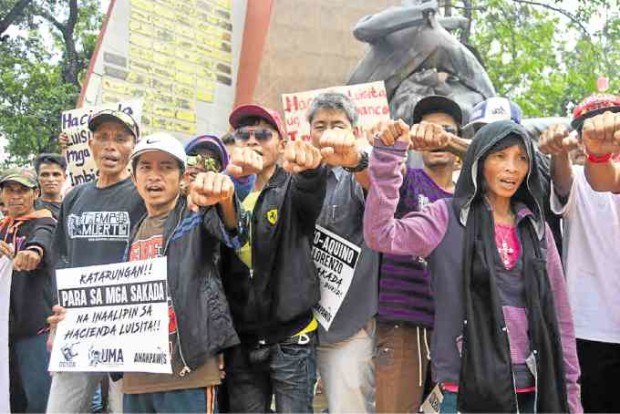Peping: Machines do jobs of ‘sacada’ in Hacienda Luisita

Farmers from Bukidnon province, who were hired to work in Hacienda Luisita in Tarlac province, stage a protest rally in Cagayan de Oro City to deplore what they described as “slave-like” treatment in the sugar estate. —JIGGER J. JERUSALEM
CITY OF SAN FERNANDO—Former Tarlac Rep. Jose “Peping” Cojuangco Jr. said Hacienda Luisita did not need to hire laborers, including “sacada” (cane cutters) recruited from Mindanao, because the estate uses mechanical harvesters to cut and collect sugar canes.
He was reacting to claims that Hacienda Luisita hired the workers, which militant groups described as a form of human trafficking. A party-list group asked Congress to investigate their alleged exploitation.
Cojuangco is one of the owners of the remaining lands not covered by agrarian reform in Hacienda Luisita in Tarlac province.
In a recent interview, Cojuangco, a former plantation manager, said: “As far as I can remember we never imported labor from Mindanao or anywhere… The only workers from outside Luisita were recruited by contractors to cut cane until we bought mechanical harvesters.”
Agrikulto Inc. requested Greenhand Labor Service Cooperative based in Polomolok, South Cotabato province, to supply 1,000 workers to “work in our farm as cane cutters” for crop year 2016 to 2017. The milling period began on Nov. 8 last year.
Article continues after this advertisementThe request was made in an Aug. 10, 2016 letter, a copy of which was provided by the Unyon ng Manggagawa sa Agrikultura (UMA), which claimed to have rescued several sacada last month.
Article continues after this advertisementIn 1989, Hacienda Luisita had 6,900 farm workers when it undertook agrarian reform through stocks distribution. But in 2012, the Supreme Court ordered the estate to instead give the farm workers 4,500 hectares of land.
But only 4,009 ha were distributed as lots for roads, canals, cemetery and other shared infrastructure were deducted, leaving the workers with only 6,600 square meters each.
House Resolution No. 678, filed on Jan. 16 by Anakpawis party-list Rep. Ariel Casilao, asked the House committees on agrarian reform and labor and employment to conduct a joint inquiry on the case of 52 sacada as “victims of human trafficking, unfair labor practices and slave-like treatment of the Greenhand Labor Service Cooperative, Agrikulto Inc. and Central Azucarera de Tarlac in Tarlac province.”
The resolution identified Cojuangco as head of Agrikulto Inc. But a certification by the Department of Labor and Employment (Dole) in Central Luzon named Roland Donasco as owner of the firm.
Ana Dione, Dole Central Luzon director, gave Greenhand the authority to recruit and hire 1,2000 migrant sugar workers for Agrikulto from November 2016 to March 2017.
UMA said instead of a daily wage, the sacada were subjected to a “pakyaw” system or a group rate of P220 per ton for cutting and hauling.
The workers had complained that a 18-ton per day quota was “physically impossible for eight to 13 cutters,” UMA said, adding they ended up earning “P9.46 to P128.31 as daily net income.”
UMA also said the sacada were housed in a “cramped, poorly ventilated and stinky bunkhouse” and forced to work from 4 a.m. to 5 p.m. in sugarcane fields “not only in Hacienda Luisita but also in Pampanga, Pangasinan or towns near Baguio City.” —TONETTE OREJAS